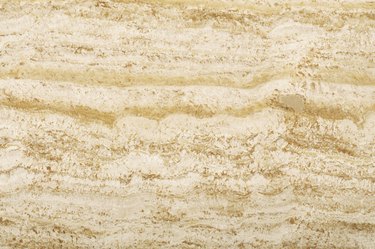 Travertine is a porous stone that absorbs stains easily. Image Credit: Ablestock.com/AbleStock.com/Getty Images
Travertine is a porous stone that absorbs stains easily. Image Credit: Ablestock.com/AbleStock.com/Getty Images
Travertine is a type of limestone that contains pitted holes. It is often cut in an irregular shape to meet specific design needs and uses. Some cuts of travertine are smoother than others. This stone is commonly used for flooring and countertops in remodels and new construction. Whether you have an older travertine floor or you wish to enhance the color of your new floor, there are ways to darken the travertine naturally. In order for the new color or stain to be effective and to adhere properly, your tile or cuts of stone must not contain any protective finish.
Video of the Day
Dye
Wood dye is typically used on hardwood surfaces to alter the color of the wood and change the overall appearance. Wood dye can also be used on travertine tile, but some dye contains harmful chemicals that may interact with the travertine or cause it to become brittle or chip. If you are looking to stain your travertine naturally, look for a nontoxic, water-based dye. You can tweak nontoxic formulas however you like without hurting the surface area around the stone. You can add as much dye as you want until you reach the level of darkness you desire. To change the color of the tile, you can add your favorite color, such as brown, black or dark red, and keep soaking the stone until it absorbs all of the dye. A water-based dye is a natural solution, so you may need to reapply frequently.
Ink
Ink is a concentrated substance that you need to water down before you use it on stone. Choose a nontoxic, chemical-free ink that is used specifically for stone. You can also use ink that is intended for use on wood. Some inks are made from natural substances, such as tempera paint and chalks. Most ink bases will need to be watered down and applied repeatedly until you reach the desired effect. Use a cloth or microfiber rag to apply the ink lightly. Avoid allowing a lot of ink to soak into one location, as this could cause staining and darkened blotches.
Oil
Natural oils allow the travertine to showcase its best colors. Oils bring out and highlight all of the natural pigments in the stone. Select a natural oil, such as olive, mineral, sunflower or linseed. Use a clean cloth to gently rub the oil on the surface of the stone, allowing it to penetrate completely. Repeat this process frequently, especially if the travertine is not going to be sealed or glazed. Do not combine natural oils with inks or dyes.
Stone Stain
A natural stone stain solution can lead to a darkened appearance on travertine. Most stone stains merely stain the surface of the travertine and don’t always penetrate all the way through. Many stone stains use natural water-based dyes and substances to penetrate the pores of the stone and also seal the stone so the stain lasts longer. Many stone stains resist water and spills, which will make your travertine shine for years to come.


